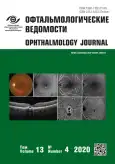Predictors of functional outcome of antiangiogenic therapy in neovascular age-related macular degeneration
- Authors: Kharakozov A.S.1, Kulikov A.N.1, Maltsev D.S.2
-
Affiliations:
- S.M.Kirov Military medical academy
- S.M. Kirov Military Medical Academy
- Issue: Vol 13, No 4 (2020)
- Pages: 7-13
- Section: Original study articles
- URL: https://journals.rcsi.science/ov/article/view/46198
- DOI: https://doi.org/10.17816/OV46198
- ID: 46198
Cite item
Abstract
Aim. To study predictive factors for functional outcome of aflibercept intravitreal antiangiogenic therapy in patients with neovascular age-related macular degeneration (nAMD).
Material and methods. Thirty-six treatment naive nAMD patients (45 eyes, 26 females and 10 males, with a mean age of 74.4 ± 10.9 years) were included in this study. All patients received 3 monthly aflibercept injections followed by 4 bimonthly aflibercept injections. Demographic characteristics, baseline best corrected visual acuity (BCVA), central retinal thickness (CRT), and structural retinal changes on optical coherence tomography (OCT) scans were evaluated for the correlation with BCVA after 10 months follow-up.
Results. At the end of the follow-up period, the mean BCVA increased statistically significantly from 31 ± 15 (~0.32) letters at baseline to 37 ± 14 (~0.4) letters (p = 0.003). CRT at baseline and at the end of follow-up was 357 ± 110 and 269 ± 70 µm (p < 0.001), respectively. Final BCVA correlated statistically significantly with baseline BCVA (r = 0.62, p < 0.0001), baseline CRT (r = –0.48, p = 0.001), and disease duration from the appearance of complaints until the therapy start (r = –0.32, p = 0.03). Structural macular changes on the OCT scans were not related to final BCVA (p > 0.05) apart from the status of the ellipsoid zone (p < 0.001). Final BCVA was statistically significantly lower in males than in females (34.7 ± 14.0 (~0.4) and 45.0 ± 9.2 (~0.63) letters, respectively, p = 0.03).
Conclusion. Baseline visual acuity, gender, CRT, disease duration from the appearance of complaints until the therapy start, and status of the ellipsoid zone are predictive for the functional outcome in wet AMD patients.
Full Text
##article.viewOnOriginalSite##About the authors
Alexandr S. Kharakozov
S.M.Kirov Military medical academy
Author for correspondence.
Email: kharakozoff@mail.ru
ORCID iD: 0000-0003-4598-0826
SPIN-code: 1208-5237
Graduated. S.M. Kirov Military Medical Academy
Russian Federation, 194044, St. Petersburg, st. Academician Lebedev, 6Alexey N. Kulikov
S.M.Kirov Military medical academy
Email: alexey.kulikov@mail.ru
ORCID iD: 0000-0002-5274-6993
MD, PhD, DSc, Assistant Professor, Head of the Ophthalmology Department. S.M. Kirov Military Medical Academy
Russian Federation, 194044, St. Petersburg, st. Academician Lebedev, 6Dmitrii S. Maltsev
S.M. Kirov Military Medical Academy
Email: glaz.med@yandex.ru
ORCID iD: 0000-0001-6598-3982
MD, PhD, Head of Medical Retina Division of Ophthalmology Department. S.M. Kirov Military Medical Academy
Russian Federation, 194044, St. Petersburg, st. Academician Lebedev, 6References
- Benyelles N, Soubrane G. [Age-related macular degeneration. (In French)]. Rev Prat. 2006;56(11):1194-1201.
- Friedman DS, O’Colmain BJ, Muñoz B, et al. Eye Diseases Prevalence Research Group. Prevalence of age-related macular degeneration in the United States. Arch Ophthalmol. 2004;122(4): 564-572. https://doi.org/10.1001/archopht.122.4.564
- Либман Е.С., Толмачев Р.А., Шахова Е.В. Эпидемиологическая характеристика инвалидности вследствие основных форм макулопатий: материалы II Всероссийского семинара «Макула-2006». – Ростов на/Д, 2006. – С. 15–22. [Libman ES, Tolmachev RA, Shahova EV. Epidemiologicheskaya kharakteristika invalidnosti osnovnykh form makulopatiy: materialy II Vserossiiskogo seminara “Makula-2006”. Rostov-on-Don; 2006. P. 15-22. (In Russ.)]
- Wong WL. Global prevalence of age-related macular degeneration and disease burden projection for 2020 and 2040: a systematic review and meta-analysis. Lancet Glob Health. 2014;2(2):106-116. https://doi.org/10.1016/S2214-109X(13)70145-1
- Boyer DS, Antoszyk AN, Awh CC, et al. Subgroup analysis of the MARINA study of ranibizumab in neovascular age-related macular degeneration. Ophthalmology. 2007;114(2):246-252. https://doi.org/10.1016/j.ophtha.2006.10.045
- Lim JH, Wickremasinghe SS, Xie J, et al. Delay to treatment and visual outcomes in patients treated with antivascular endothelial growth factor for age-related macular degeneration. Am J Ophthalmol. 2012;153(4):678-686. https://doi.org/10.1016/j.ajo.2011.09.013
- Ying GS, Huang J, Maguire MG, et al. Baseline predictors for one-year visual outcomes with ranibizumab or bevacizumab for neovascular age-related macular degeneration. Ophthalmology. 2013;120(1): 122-129. https://doi.org/10.1016/j.ophtha.2012.07.042
- Mitamura Y, Mitamura-Aizawa S, Katome T, et al. Photoreceptor impairment and restoration on optical coherence tomographic image. J Ophthalmol. 2013; 2013:518170. https://doi.org/10.1155/2013/518170
- Oishi A, Tsujikawa A, Yamashiro K, et al. One-year result of aflibercept treatment on age-related macular degeneration and predictive factors for visual outcome. Am J Ophthalmol. 2015;159(5):853-860. https://doi.org/10.1016/j.ajo.2015.01.018
- Coscas F, Coscas G, Lupidi M, et al. Restoration of outer retinal layers after aflibercept therapy in exudative AMD: Prognostic value. Invest Ophthalmol Vis Sci. 2015;56(6):4129-4134. https://doi.org/10.1167/iovs.15-16735
- Kwon YH, Lee DK, Kim HE, et al. Predictive findings of visual outcome in spectral domain optical coherence tomography after ranibizumab treatment in age-related macular degeneration. Korean J Ophthalmol. 2014;28(5):386-392. https://doi.org/10.3341/kjo.2014.28.5.386
- Ferrara D, Silver RE, Louzada RN, et al. Optical coherence tomography features preceding the onset of advanced age-related macular degeneration. Invest Ophthalmol Vis Sci. 2017;58(9):3519-3529. https://doi.org/10.1167/iovs.17-21696
- Lee H, Ji B, Chung H, et al. Correlation between optical coherence tomographic hyperreflective foci and visual outcomes after anti-VEGF treatment in neovascular age-related macular degeneration and polypoidal choroidal vasculopathy. Retina. 2016;36(3):465-475. https://doi.org/10.1097/iae.0000000000000645
- Wickremasinghe SS, Sandhu SS, Busija L, et al. Predictors of AMD treatment response. Ophthalmology. 2012;119(11): 2413-2414. https://doi.org/10.1016/j.ophtha.2012.06.056
- Будзинская М.В., Фурсова А.Ж., Педанова Е.К. Специфические биомаркеры ответа на антиангиогенную терапию // Вестник офтальмологии. - 2020. - Т. 136. - № 2. - С. 117-124. [Budzinskaya MV, Fursova AZh, Pedanova EK. Specific biomarkers of response to antiangiogenic therapy. Russian annals of ophthalmology. 2020;136(2):117-124. (In Russ.)] https://doi.org/10.17116/oftalma2020136021117
- Zhang X, Lai TY. Baseline predictors of visual acuity outcome in patients with wet age-related macular degeneration. Biomed Res Int. 2018;2018:9640131. https://doi.org/10.1155/2018/9640131
- Leung K, Downes S, Chong V. A retrospective analysis of the effect of subretinal hyper-reflective material and other morphological features of neovascular age-related macular degeneration on visual acuity outcomes in eyes treated with intravitreal aflibercept over one year. Vision (Basel). 2018;2(1):5. https://doi.org/10.3390/vision2010005
Supplementary files










